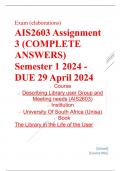Exam (elaborations)
AIS2603 Assignment
3 (COMPLETE
ANSWERS)
Semester 1 2024 -
DUE 29 April 2024
Course
Describing Library user Group and
Meeting needs (AIS2603)
Institution
University Of South Africa (Unisa)
Book
The Library in the Life of the User
[School]
[Course title]
, Exam (elaborations)
AIS2603 Assignment 3 (COMPLETE ANSWERS)
Semester 1 2024 - DUE 29 April 2024
Course
Describing Library user Group and Meeting needs (AIS2603)
Institution
University Of South Africa (Unisa)
Book
The Library in the Life of the User
AIS2603 Assignment 3 (COMPLETE ANSWERS) Semester 1 2024 - DUE
29 April 2024 ;100% TRUSTED workings, explanations and solutions
Question 1 Determine the community information needs needed by users
in your settings or places. (15)
Understanding the community's information needs is crucial for providing effective services
and support. Here are some considerations to help determine the community information
needs in your setting or place:
1. Demographic Information: What are the demographics of the community? Consider
factors such as age, gender, income level, education level, occupation, and cultural
background.
2. Community Priorities: What are the top priorities or concerns of the community
members? Are there any pressing issues or challenges they are facing, such as
unemployment, access to healthcare, housing affordability, or environmental
sustainability?
3. Local Resources and Services: What are the existing resources and services
available in the community? Are there any gaps or areas where additional support is
needed? This could include social services, healthcare facilities, educational
institutions, recreational activities, and employment opportunities.
4. Communication Preferences: How do community members prefer to receive
information? Do they rely more on traditional media channels like newspapers and
radio, or do they prefer digital platforms such as social media, websites, or mobile
apps? Understanding their communication preferences can help tailor information
dissemination strategies.
5. Language and Accessibility: Are there language barriers within the community? Do
certain groups require information in languages other than the dominant language?
Additionally, consider accessibility needs, such as providing information in formats
suitable for individuals with disabilities.




